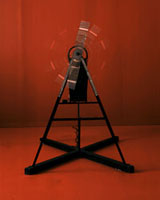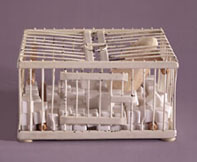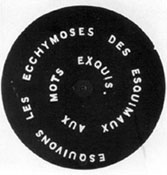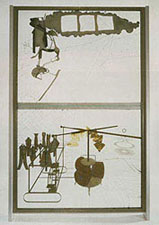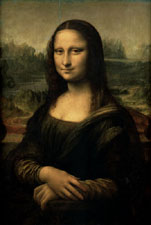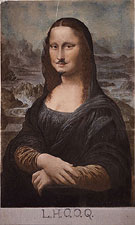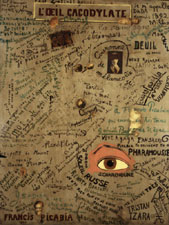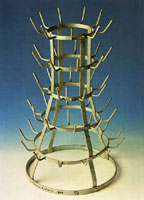|
[1]
In 1920 Marcel Duchamp duplicated himself by selecting a feminine semblance: that of Rose Sélavy. This name is used for the copyright of Fresh Widow (Fig. 1), a ready-made obtained by a craftsmanlike montage of a green window in French style, with black leather panels. Duchamp insisted that these panels be polished every day. Maybe it was for this reason—daily lubricated rubbing of that leather—that, in Duchamp’s transformation, the French Window became a Fresh widow that is to say a Wanton widow. From that moment Rose’s works multiplied. In 1920 as ever, her name was linked to the motor-driven optical appliance known as Rotative plaques verre (optique de précision) (Fig. 2). The ready-made from 1921, made up of a small cage built with marble cubes and cuttlefish bone was named Why not sneeze Rose Sélavy? (Fig. 3) The woman’s sensual phrases are written in spiralling white letters on nine black disks in the short film entitled Anémic Cinéma (Fig. 4) shot a Man Ray’s and shown on 30 August 1926 in a Paris cinema: while they rotate, the disks create pulsating, erotic sensations. In September 1934, the woman also launched her publications with a book of perfect, albeit late, dadaist expression: a box named La Mariée mise à nu par ses célibataires, même (Fig. 5) containing facsimile notes and reproductions, better known as the Boîte verte. But there was still more: in April 1939, 515 copies of a pamphlet of writings by Marcel Duchamp entitled Rrose Sélavy were published in Paris the collection was described as “poils et coups de pied en tous genres”. click
on images to enlarge
In the meantime, the name Rose had changed to Rrose. This happened in 1921: a play on words published on page 6 of “Le Pilhaou-Thibaou” (fifteenth issue of the 391 magazine) was signed Rrose Sélavy. Picabia had abstracted the phrase from a letter which Duchamp had sent him from New York in January. It was the first time that an “r” was added to that flowery name, which did no more than duplicate the recently created personage. Simply adding a consonant was enough to better delineate the mystery of doubling: a newly born creature began to transform immediately and possess her own “biography”. Photographic documentation of Rrose also exists. In 1921 Man Ray collaborated in the one-and-only issue of the New York Dada magazine, publishing a photograph he had taken of Duchamp in the feminine attire of Rrose Sélavy wearing a little hat with a band and geometric patterns, and holding an elegant fox neckband, feeling its warmth with “her” hands. The photograph depicts a face with an elusive expression—mysteriously smiling lips, eyes subtly indifferent.The attractive hat had been lent to Marcel-Rrose by Germaine Everling, Picabia's partner. The anti-romantic Duchamp had chosen, as the clearest sign of his transformation, headgear which belonged to a woman whose name, Germaine, alluded to the burning core of romantic illusion - germanism. Rrose’s indifferent smile reminds us of the Gioconda (Fig. 6). In his L.H.O.O.Q. (Fig. 7) ready-made of 1919 Duchamp had already deformed the Gioconda by drawing a pair of thin whiskers on a reproduction of Leonardo’s renowned painting.(1) click
on images to enlarge
What Rrose represents can be clarified by the dedication on the photograph, which reveals her identity: “Lovingly, Rrose Sélavy alias Marcel Duchamp.” So it was another “I” to be added to the existing one, without hiding anything. Nevertheless, Rrose sought a legal personality and soon “she” obtained a visiting card:
There is no need for one to know that more than plenty moustaches were sold at Marcel-Rrose’s emporium, to understand that the pseudonym pointed phonetically in an erotic direction: Rrose Sélavy actually sounds like “Eros c’est la vie” [Eros: that’s how life is]. But it went further then that. In a conversation with Pierre Cabanne, Duchamp expressed some illuminating thoughts:
“I wanted to change my identity and had the idea of taking a Hebrew name. I was a Catholic, and this new religion already meant a change. But I did no find any Hebrew name that I liked, or that struck my imagination, and I suddenly had an idea: why not change sex? That is how the name Rrose Sélavy came about. It sounds quite good today, because names too change through time, but in 1920 it was a silly name. The double ‘R’ is linked to the Picabia’s painting Oeil Cacodylate (Fig. 8), exhibited at the ‘Le Boeuf sur le Toit’ cabaret—I don’t know if it was sold—and Picabia asked all friends to sign the painting. I don’t remember what I wrote, but the painting was photographed and, therefore, someone must know. I think I wrote ‘Pi Qu'habilla Rrose Sélavy’.”(2) The phrase Duchamp wrote on Picabia’s painting sounds phonetically like “Picabia l'arrose c'est la vie”. And this broadens the meaning from “Eros c’est la vie” to the phrase “Arroser la vie”, that is “have a drink over it, make a toast to life.” Both meanings refer to Duchamp’s view of life: a first, superficial consideration of Duchamp’s transformation into Rrose Sélavy seems to trigger a vivacious play of interpretation, but a more precise observation shows that the transformation coagulates lasting eroticism: the one stemming from joie de vivre and the delight in letting one’s thoughts wander freely. In fact, in addition to signing some ready-mades, Rrose wrote bon-mots, word plays that are intentionally senseless, but at times sound highly explicit. So Rrose has a “linguistic” personality born of a precise idea of language. In an interview published in L’Express on 23 July 1964, Duchamp stated: “Language is an error of humanity. Words do not express the depth of feeling between two beings who love each other. A word is a worn pebble applied to thirty-six shades of affectivity. Language is convenient for simplifying, but I detest it as a means of locomotion.” “And yet—the interviewer insisted—you took an interest in language under the pseudonym of Rrose Sélavy.” “That was to have fun. I have a lot of respect for humour, it’s a kind of safety-net enabling us to pass through all mirrors.”(3)
What does one get out of reading Rrose’s sayings? Simply the joy of reading something new all the time, an experience that may remind you of gathering the fruits of Eden. Duchamp had foretold it in 1911, with his painting Jeune homme et jeune fille dans le printemps (Fig. 9) : a scene of pagan joy where a young nude couple freely gather the fruits from a plant growing amid flourishing nature. The essential question is that only woman can make herself understood without recourse to meaning, as in Rrose’s aphorisms. In other words, only woman is impregnable. Like irony.
Duchamp pursues a primitive form of eros: this can be evinced from his idea of marriage, seen as a blind alley, as the tomb of love. The Dimanches caricature of 1909 is merciless in this respect: on Sundays, the married couple, with the newly born child, are reduced to a boring walk where the man pushes the pram while his newly pregnant wife walks tiredly by his side. As concerns his opting to be a single, attracted by women but refusing marriage, Duchamp once said to Pierre Cabanne: “I realised while still young that one should not weigh oneself down with too much ballast, too many jobs, with a wife, children, a country house, a car—fortunately I was sure of this from the start. And that’s why I’ve been able to live in a much more simple way as a bachelor, than I would have if I’d had to deal with all the usual problems of life.” Duchamp always defended this sense of freedom, and on one occasion, when writing to Arturo Schwarz on the meaning of marriage, he said: “I carefully avoided it until I was 67. I married a woman who, due to her age, could not have any children.” In actual fact, he had already been married in 1927, but only stayed married for the laughable period of three months. For Duchamp eros is something serious—it is what makes up absent irony. In an interview of 8 December 1961 Alain Jouffroy asked Duchamp if he thought that humour was indispensable for creating a work of art, and Duchamp replied: “Of course. I’m particularly attached to humour, because seriousness is a very dangerous thing. You need humour to avoid being serious. The only serious thing I could consider is eroticism—that is definitely serious.” (4) This idea is the bedrock of Rrose Sélavy’s philosophy, an author who converts the pathos of aphorism into pleasure, and the emotion of writing into thought. Her procedure is based on eroticism, since eros springs from the situation of continuous novelty: thought becomes erotic when it occurs as constantly forming thought, and as such, it emerges in Duchamp’s works in 1911 and 1912: Dulcinée; Jeune homme triste dans un train; Nu descendant un escalier. To seek erotic novelty, one must use language in its elementary components. For Rrose, language is the chocolate ground by Duchamp in his Broyeuse de chocolat (1914) to obtain cocoa powder which, with the addition of humour-sugar, becomes a sweet powder to be used in many different mixtures—something one cannot do with solid chocolate.
Moreover, there is a Duchamp ready-made which can be interpreted in an anti-phrasal sense: Egouttoir from 1914, the round bottle rack (Fig. 10) that stands without any support—a very common object in wine-conscious France. It apparently resembles what must not happen in language: Rrose’s aphorisms must not dry out like the bottles inserted neck down in the bottle rack. Egouttoir obviously refers to the verb égoutter, to drip, which, in turn, is closely linked to égoûter, to take taste away: if something has dried out, it loses its taste. The erotic procedure implies preservation of taste: eroticism is the difference, not repetitiveness. One of the cardinal points of Duchamp’s biography is the reason why he abandoned painting: when he was questioned about it, he always replied in the same way. In an interview which appeared on 23 October 1965 in the Spanish magazine Siglo XX he answered that it was “due to repetition: one can do three or four exceptional things, but all the rest is repetition.” In an interview published in “Paris-Normandie” on 12 April 1967, he said that “there’s nothing more boring than repetition. Everything that is neither unusual nor singular falls into oblivion.” But eroticism also implies the need to flee from unmoving taste created by a static tradition. In the short film entitled A conversation with Marcel Duchamp broadcast by NBC on 15 January 1956, Marcel stated at a certain point that there was a danger of arriving at a kind of taste: “if it is repeated a certain number of times, the thing becomes taste.”(5) If there is a risk that Duchamp has steadfastly avoided, it is that of repeating oneself: he continuously attempted to explore new paths of expression until his self-imposed silence. Duchamp takes us by the hand and leads us to a luxurious vision of Nothing: in spite of this, his works arouse excitement. This is true of the body in Jeune homme triste dans un train, and of the nude body going down the stairs: each takes on an ever-different shape, like ideas, by way of their liquid and eternally mobile nature. Duchamp did not choose to depict still shapes, instantaneous views of a single moment. In the same way, Rrose’s aphorisms are not linguistic forms correlated to common logic. Duchamp eliminates all reference to authority; he does so by melting meaning in a soft dough to be used freely. A man (the artist) traces a sign and lets another man (the user) draw from it the meaning he wants. So we have man, round and fleshy; then there’s the Sign, geometric and squeaky like the nib that traces it; lastly there are the Meanings, the sea of Nothingness. One can create authority with the Sign: utopias and theologies can be created. Assigning a meaning to the Sign is like establishing relations of authority. But one can also free the Sign of authority: that is how we obtain the erotic action, the duty of indifference, the nullification of sense. If we deprive the Sign of Meaning, purity appears. Duchamp managed to free—with a gesture of art—the Sign of Meanings, and allow the Sign to soak in the Meaning which the user arbitrarily assigns to it. This is freedom of Meaning, gesture of art, and, in its essence, a “political” gesture, [3] In the Dictionnaire abrégé du surréalisme Éluard and Breton include Duchamp’s definition of ready-made: “A common-or-garden object promoted to the dignity of art by the artist’s simple choice.” However, Duchamp crops up in other points of the dictionary, and the initials M.D. which sign the item “Hasard” are perhaps his: “Hasard en conserve”: The definition means “Chance preserve”; it could be deformed into “Chance jam”, and one could certainly find a meaning there—definitely not intended by Duchamp. One could surmise that chance eminently mixes with remaining chance to make jam from every single existence. In Duchamp’s case, he reaches the preserve by a purely arbitrary act. In his work, he induces the observer to interpret, to make a comment, to add other data to the datum (perhaps the simple datum of ready-made). However, everything is arbitrary, useless and sterilely inefficient. Rrose’s (and Duchamp’s) production provokes an arcane stupor that refuses any rational speculation. Rrose’s eroticism leads to a sterility with a gnostic taste: there is, in fact, a kind of sterile celibacy in Rrose Sélavy’s sayings. They are arbitrary phrases that arouse an idea, an image, a reaction by comment, and a set of interpretations which are, in turn, sterile and needlessly reiterated to infinity. And this leads us to Giordano Bruno’s great religious intuition: that infinite universe contrasting with the needs of a finite universe on which Tomism was based. Nevertheless, Bruno fills matter with divinity (pantheism), whereas Duchamp shows that matter is an endless nothingness. Bruno claims a gesture of conscience: to become aware that infinity is God’s image present in each grain of the universe; instead Duchamp claims a gesture of unawareness: “The unaware is an orphan, an atheist, a single person.”(6) Celibacy and atheism can be preserved only through unawareness. The single person is a figure of the incredulous, just as the orphan is the figure of abandonment to nothingness. In a religious environment, Duchamp cultivates a pure kind of atheism, rising up from preserved chance. But although arbitrariness dominates Duchamp’s actions, his choice of sterility is a free one. He could choose to be fertile, but, instead, he elects to be sterile, and leaves the multiplication of nothing to be performed by the fertile, i.e. by “others”. He leaves us a castle as his heredity: the sterile multiplication of the interpretations of his works of art or in the case of Rrose—of his aphorisms. In this way, he establishes a two-way relationship. The sterile part allows the fertile part to perpetuate its useless fertility; the fertile part enables the single-sterile person to stay that way. It enables him/her to enjoy the pleasure of onamism (the single person is an onanist by definition). No less important is the fact that in Rrose’s visiting card the first title is the corporate “Precision optics”. it is a clear invitation that, when doing business with Rrose, one should view matters carefully without overlooking anything, or, at least, without down-ranking some observations for which special optics are required. We are concerned with gnostic optics. The gnostic idea is that man is a tiny light turned on in the dark prison of the world, full of pain and evil. Escape from the world is possible only through purification, which can be pursued by transformation into a divine creature. Rrose is both an erotic creature and a pure one. Through her birth, like the birth of Spring from the sea waves in Botticelli’s painting, Duchamp achieved an unprecedented conquest of knowledge and vision. His transformation into a female personage was not a sacrifice in the name of the Great Mediterranean Mother, but the gnostic definition of the pure being (Catharist) as a creature living beyond the world. An admirer of all modern forms of expression, Breton was another who often considered Duchamp’s figure. In Testimony 45, an article which appeared in March 1945 in the special issue of View, the USA magazine, dedicated to Duchamp, Breton posed himself a radical question: to what extent, after the appearance of Duchamp’s greatest work La Marié mise à nu, is it justifiable to continue painting as if that work did not exist. In Breton’s eyes, the appearance of Duchamp becomes something increasingly imperative: “It tends to denounce the greater part of recent artistic production as obsolete and vain.”(7) Here we can see Duchamp’s purifying action, his evangelical catharism: to make a clean sweep, to impose the need for the Radically New. He did this by incarnating himself in Rrose Sélavy, and by creating an Erotic Gnosis, or, if you prefer, Gnostic Eroticism: in any event, reaching a peak in order to understand what is worth trying in the world, and in life.
Notes
The eroticism pursued by Duchamp seems to be reflected in the theory expressed by Susan Sontag in her essay “Against Interpretation”; the American writer states that the vitality of an interpretation can be justified by being based on an “erotic” rather than a “hermeneutic” procedure.
Figs.
1-5, 7, 9-10
|
|||||||||||||||||||||||||

